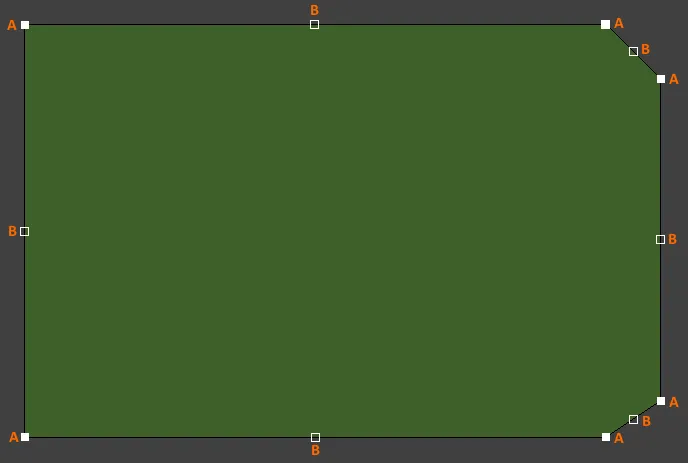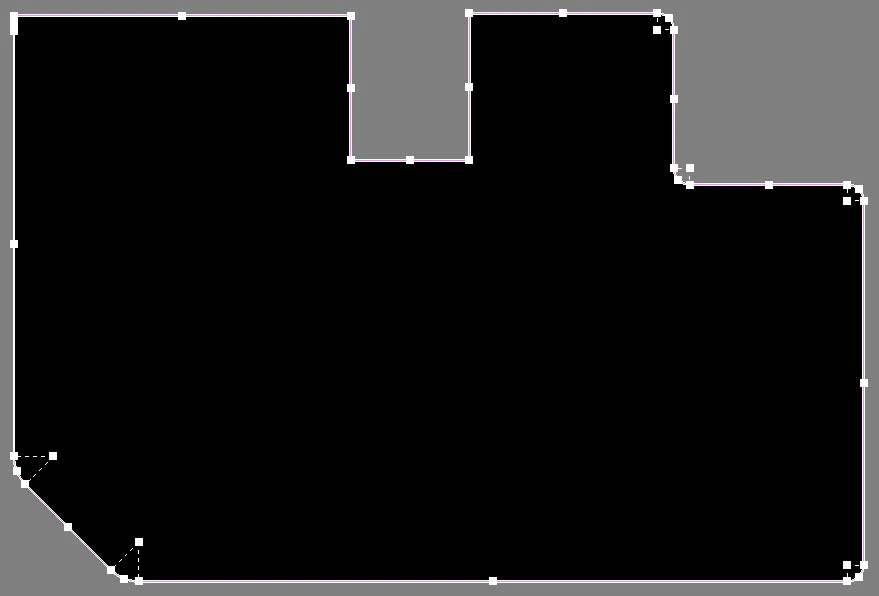The board shape, also referred to as the board outline, is a closed polygon that defines the boundary, or extents, of the board. As well as providing a visual guideline of the extents of the space available for the placement and routing of the design, the board shape is also used by the internal power planes as the reference for the power plane edge pullback and the edge for splitting power planes. When a new PCB file is created, it opens with a default board shape.
For a blank PCB project or additional PCB documents added to an existing project, the default board shape is a square shape. For specific project templates that can be used when creating a new PCB project, the associated PCB document in each case has a specific board shape according to the form factor of the board.
The board shape is not used for output generation; it is only the placed objects that are used.
Use the Board Shape drop-down to access the following commands.

- Redefine Board Shape - use to interactively draw a new shape.
- Move Board Shape - use to move the location of the board shape within the design space.
- Edit Board Shape - use to interactively modify the shape of the board by moving vertices or sliding the edges of the shape.
- Define From Selected Objects - select a set of lines and/or arc primitives that define a closed shape then use this command to redefine the board shape to match this shape.
- Create Primitives From Board Shape - use when the board shape exists but there are currently no objects along the boundary.
The above commands are only available while viewing the board in 2D.
Redefining the Board Shape
After launching the Redefine Board Shape command, the cursor will change to a crosshair and you will enter the standard polygonal object placement mode. Board shape definition is made by performing the following sequence of actions:
- Position the cursor and click to anchor the starting vertex for the board shape.
- Move the cursor ready to place the second vertex. The default behavior is to place two edges with each click, with a user-defined corner shape between them. Refer to the Placement Modes section below for more details on changing corner modes.
- Continue to move the mouse and click to place further vertices.
- After placing the final vertex, right-click or press Esc to close and complete the definition of the board shape. There is no need to manually close the board shape since the software will automatically complete the shape by connecting the start point to the final point placed.
Placement Modes
When redefining the board shape there are five available corner modes, four of which also have corner direction sub-modes. During redefinition:
- Press Shift+Spacebar to cycle through the five available corner modes: 45 degrees, 45 degrees with arc, 90 degrees, 90 degrees with arc, and Any Angle.
- Press Spacebar to toggle between the two corner direction sub-modes.
- When in either of the arc corner modes, hold the < or > keys to shrink or grow the arc. Hold the Shift key as you press to accelerate arc resizing.
- Press the 1 shortcut key to toggle between placing two edges per click, or one edge per click. In this second mode, the dashed edge is referred to as the look-ahead segment (as shown in the last image in the set below).
- Press the Backspace key to remove the last vertex.






Graphically Editing the Board Shape
After launching the Edit Board Shape command, the existing board shape will turn green. The outer shape of the shape is defined by a series of edges, where each edge is represented by an end vertex at each end, shown as a solid white square, and a center vertex in the middle, shown as a hollow white square. Each end vertex represents the location where two edges meet.

- Click and drag A to move the applicable end vertex.
- Click and drag B to move the applicable center vertex, effectively creating a new end vertex and splitting the original edge into two.
- Click anywhere along an edge, away from editing handles, and drag to slide that edge.
- Ctrl+click anywhere along an edge, away from editing handles, to insert a new end vertex.
- Click and hold on an end vertex then press Delete to remove that vertex.
Exit editing mode by clicking anywhere in the design space (on or away from the board shape).
Graphically Moving the Board Shape
After launching the Move Board Shape command, the existing board shape will turn green and an outline copy of the shape will be attached to the cursor. Move the shape to the desired new location within the design space and click to effect placement. While moving, the board shape can be rotated or mirrored:
- Press the Spacebar to rotate the board shape counterclockwise or Shift+Spacebar for clockwise rotation. The Rotation Step size is defined on the PCB Editor – General page of System Preferences.
- Press the X or Y keys to mirror the board shape along the X-axis or Y-axis respectively.

Defining the Shape from Selected Objects
The board shape can also be defined from selected objects. Typically this will be a set of lines and/or arcs placed on a mechanical layer. Once all the objects are selected, select the Define from selected objects command. The board shape will update to follow the path defined by the selected lines. A warning dialog will appear if the software is unable to follow the centerline of the selected objects.

Creating Primitives from the Board Shape
As well as defining the board shape from selected primitives, it also is possible to create primitives from the board shape. Use the Create Primitives from Board Shape command when the board shape exists but there are currently no objects along the boundary. Situations where this command can be useful include:
- When you want to modify the board shape (or board cutouts) by modifying track and arc primitives first.
- When you need a keepout boundary for the board or keepout boundaries for board cutouts.